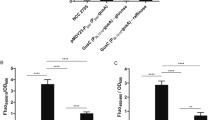Abstract
Objectives
To determine the effectiveness of evoglow-Pp1 as a reporter to study gene expression in bifidobacteria. To choose a strong and constitutive promoter to track fluorescently labelled bifidobacteria in environments under anaerobic conditions.
Results
The elongation factor P (EF-P) promoter from Bifidobacterium longum CECT 4551 produced the highest emission of fluorescence signal and was therefore able to produce the highest gene expression of the promoters studied. The promoters from B. longum CECT 4551 showed different fluorescence signal intensities which, in descending order, were: EF-P, initiation factor IF-2, elongation factor G, elongation factor Tu, elongation factor Nus A, elongation factor Ts and 30S ribosomal protein S12.
Conclusions
The consistency of the methods employed (fluorescence imaging system, fluorescence microscopy, fluorimetry and flow cytometry) showed that the construction pNZ:Prom.GFPana contained the anaerobic fluorescent protein evoglow-Pp1 could be exploited as a tool for analysing the gene expression in bifidobacteria strains.




Similar content being viewed by others
References
Akay H, Bahar Tokman H, Hatipoglu N, Hatipoglu H, Siraneci R, Demirci M, Borsa BA, Yuksel P, Karakullukcu A, Kangaba AA, Sirekbasan S, Aka S, Mamal M, Kocazeybek BS (2014) The relationship between bifidobacteria and allergic asthma and/or allergic dermatitis: a prospective study of 0–3 years-old children in Turkey. Anaerobe 28:98–103
Ballongue J (1998) Bifidobacteria and probiotic action. In: Salminen S, von Wright A (eds) Lactic acid bacteria. microbiology and functional aspects. CRC Press, New York, pp 519–587
Cronin M, Sleator RD, Hill C, Fitzgerald GF, van Sinderen D (2008) Development of a luciferase-based reporter system to monitor Bifidobacterium breve UCC2003 persistence in mice. BMC Microbiol 8:161
Drepper T, Eggert T, Circolone F, Heck A, Krauss U, Guterl JK, Wendorff M, Losi A, Gärtner W, Jaeger KE (2007) Reporter proteins for in vivo fluorescence without oxygen. Nat Biotechnol 25:443–445
Errampalli D, Leung K, Cassidy MB, Kostrzynska M, Blears M, Lee H, Trevors JT (1999) Applications of the green fluorescent protein as a molecular markers in environmental microorganisms. J Microbiol Methods 35:187–199
Fijan S (2014) Microorganisms with claimed probiotic properties: an overview of recent literature (Review). Int J Environ Res Public Health 11:4745–4767
Greer LF III, Szalay AA (2002) Imaging of light emission from the expression of luciferases in living cells and organisms: a review. Luminescence 17:43–74
Gromadski KB, Wieden HJ, Rodnina MV (2002) Kinetic mechanism of elongation factor Ts-catalyzed nucleotide exchange in elongation factor Tu. Biochemistry 41:162–169
Guglielmetti S, Ciranna A, Mora A, Parini C, Karp M (2008) Construction, characterization and exemplificative application of bioluminescent Bifidobacterium longum biovar longum. Int J Food Microbiol 124:285–290
Hartemink R, Kok BJ, Weenk GH, Rombouts FM (1996) Raffinose-Bifidobacterium (RB) agar, a new selective medium for bifidobacteria. J Microbiol Methods 27:33–43
Holo H, Nes IF (1989) High-frequency transformation, by electroporation, of Lactococcus lactis subsp. cremoris grown with glycine in osmotically stabilized media. Appl Environ Microbiol 55:3119–3123
Klijn A, Moine D, Delley M, Mercenier A, Arigoni F, Pridmore RD (2006) Construction of a reporter vector for the analysis of Bifidobacterium longum promoters. Appl Environ Microbiol 72:7401–7405
Landete JM, Peirotén A, Rodriguez E, Margolles A, Medina M, Arqués JL (2014) Anaerobic green fluorescent protein as a marker of Bifidobacterium strains. Int J Food Microbiol 175:6–13
Lee JH, Karamychev V, Kozyavkin S, Mills D, Pavlov A, Pavlova N, Polouchine N, Richardson P, Shakhova V, Slesarev A, Weimer B, O’Sullivan DJ (2008) Comparative genomic analysis of the gut bacterium Bifidobacterium longum reveals loci susceptible to deletion during pure culture growth. BMC Genom 9:247–262
Overkamp W, Beilharz K, Detert Oude Weme R, Solopova A, Karsens H, Kovács Á, Kok J, Kuipers OP, Veening JW (2013) Benchmarking various green fluorescent protein variants in Bacillus subtilis, Streptococcus pneumoniae, and Lactococcus lactis for live cell imaging. Appl Environ Microbiol 79:6481–6490
Perera J, Tormo A, García JL (2002) Ingeniería genética. Vol. II: Expresión de DNA en sistemas heterólogos. Ed. Sintesis S.A. Madrid, pp 392
Rossi D, Kuroshu R, Zanelli CF, Valentini SR (2014) eIF5A and EF-P: two unique translation factors are now traveling the same road. Wiley Interdiscip Rev 5:209–222
Sakanaka M, Tamai S, Hirayama Y, Onodera A, Koguchi H, Kano Y, Yokota A, Fukiya S (2014) Functional analysis of bifidobacterial promoters in Bifidobacterium longum and Escherichia coli using the α-galactosidase gene as a reporter. J Biosci Bioeng 118:489–495
Sun Z, Baur A, Zhurina D, Yuan J, Riedel CU (2012) Accessing the inaccessible: molecular tools for bifidobacteria. Appl Environ Microbiol 78:5035–5042
Tannock GW, Munro K, Harmsen HJM, Welling GW, Smart J, Gopal PK (2000) Analysis of the fecal microflora of human subjects consuming a probiotic containing Lactobacillus rhamnosus DR20. Appl Environ Microbiol 66:2578–2588
Wang Y, Kim J, Park M, Ji G (2012) Novel Bifidobacterium promoters selected through microarray analysis lead to constitutive high-level gene expression. J Microbiol 50:638–643
Acknowledgments
This work was supported by projects RTA2010-00116-00-00 and RM2012-00004-00-00. J. M. Landete has a postdoctoral contract with the research program “Ramón y Cajal” (MINECO, Spain).
Author information
Authors and Affiliations
Corresponding author
Rights and permissions
About this article
Cite this article
Montenegro-Rodríguez, C., Peirotén, A., Sanchez-Jimenez, A. et al. Analysis of gene expression of bifidobacteria using as the reporter an anaerobic fluorescent protein. Biotechnol Lett 37, 1405–1413 (2015). https://doi.org/10.1007/s10529-015-1802-8
Received:
Accepted:
Published:
Issue Date:
DOI: https://doi.org/10.1007/s10529-015-1802-8




